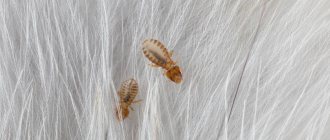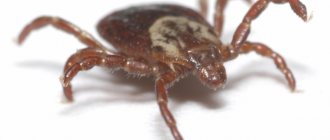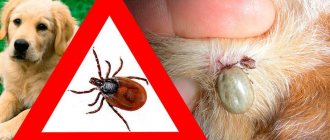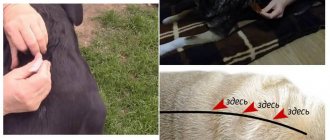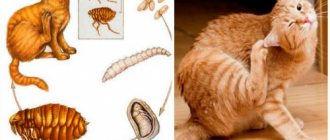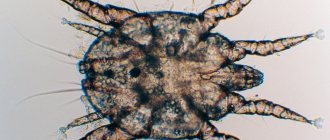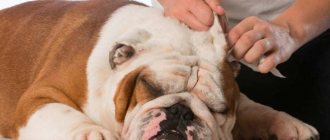Photos and descriptions of lice eaters: who are they, what do they look like and what is their structure?
Lice-eaters, also called wool-eaters, are representatives of the order of lice-eaters, and not a subclass of ticks.
Ectoparasites are localized in the fur of mammals. In addition to dogs and cats, they parasitize farm animals: sheep, cows, horses. About 200 species of these arthropods are known, of which 120 can be found in our country. The appearance and internal structure of these insects have the following features:
- The flattened body is pale yellow in color. The length of most individuals is 1–2 (maximum 10) mm.
- Shield-shaped large head. Its dimensions exceed the width of the parasite's chest.
- There are no wings, so the lice eater is deprived of the ability to fly.
- Three pairs of limbs equipped with claws, with the help of which their owners hold securely on the owner’s fur. The legs are attached to the chest.
- An elongated abdomen formed by segments covered with setae.
- Three-segment antennas.
- The mouthparts are gnawing type. It is formed by the upper and lower jaws, a thickened upper lip and the teeth covering it. You can see what the parasite looks like in the photo.
These arthropods feed on epidermal cells, secretions of the sebaceous glands and blood, which they suck by biting into the skin of the victim. Pests develop on the host's body. They are characterized by incomplete transformation. The life cycle includes 3 phases: egg, larva, adult. Each female lays from 5 to 7 dozen eggs during her life, after fertilization, using a special substance, gluing nits to the fur of the mammal.
Externally, the larvae differ from the imago only in size. Before turning into an adult insect, they go through 3 instars, each of which ends with molting. The break between them ranges from 2 to 12 days. The duration of the larval stage of development is about 20 days.
What kind of insect is a lice eater?
The world's entomofauna includes over 200 species of lice-eaters, which belong to the order of parasitic insects - lice and lice. In some sources they are found under the name wool beetles.
It is important to note the strict specialization of these parasites. Various lice eaters live on dogs, cats and various types of cattle. They are united by their small size and feeding habits. Any lice eater feeds on epidermal cells, sebaceous gland secretions, fur scales and blood from damaged skin of animals. However, for example, a dog lice eater will not parasitize cats and vice versa. Although both types of insects pose the same danger to animals and humans.
Infection process and symptoms
There is only one way of infection by lice eater - through direct contact:
- Contact with an infectious animal. Most often, when interacting with stray animals, pets become infected with lice and fleas.
- Even if we exclude any interaction between a domestic dog and any stray animals, there is still a risk of infection. Lice eaters are too small to be seen with the naked eye, and a dog owner may unknowingly carry the parasite on their hands, shoes or clothing.
- From mother to puppy, with direct contact.
If an animal is infected, but there are still few parasites and they are not active enough, it is very difficult to detect them. But when lice eaters multiply, the disease can be identified by the following symptoms:
- The dog experiences severe itching, which is why it scratches constantly.
- The presence of light flakes in the dog's fur, similar to dandruff. Lice eaters are sedentary parasites, but upon very careful examination you can see how these “flakes” move.
- The dog's fur becomes dull, brittle, becomes matted and sticks together.
- Partial baldness may occur - the inner thighs and base of the tail are especially susceptible to this.
- When there are a lot of parasites and they cause severe discomfort to the pet, the dog may lose its appetite, become apathetic, and lose weight.
Prevention
Getting rid of lice in dogs is not easy and requires effort, so it is better to try to prevent infection. Veterinarians advise adhering to the following rules of prevention:
- Examine the dog as often as possible, care for the coat, and carry out hygiene procedures.
- Periodically wash combs, brushes, wash the bedding or bed.
- Pay attention to behavior, monitor appetite and need for water.
- When visiting public places with other dogs present, treat with repellents. Their action is aimed at repelling parasites.
- Do not allow contact with stray animals.
- Wear an anti-parasite collar when walking.
Maintaining the health of the dog is the main task of the owner. If you give your pet due attention and follow the prevention recommendations, lice-eater infestation can be avoided. Those who were unable to protect their pet from the pest should immediately take measures to get rid of it. Whatever method of combating lice eaters in dogs is chosen, it must be agreed with a veterinarian.
Danger to your pet
The ectoparasite, which is the lice eater, not only brings discomfort to the animal, but can also be a carrier of helminths and be a catalyst for the development of other unpleasant and dangerous diseases.
If there are lice eaters on the dog’s body, there is a very high probability of developing trichodecosis.
Lice eaters cause severe itching in the dog and, by furiously combing and biting the fur, the pet injures itself, and open wounds appear that can become infected.
The presence of parasites in general greatly weakens the dog’s body, immunity decreases, and chronic diseases or allergic reactions can worsen. Due to a decrease in the body's protective functions, the dog is susceptible to various viral or infectious diseases.
trichodectosis in a dog
Possible complications
Long-term infection of a dog with lice eaters can cause the development of dermatological diseases, the appearance of wounds and scratches on the pet’s skin. It is possible to develop helminthiasis, which is carried by parasites. Due to severe itching, the animal becomes irritable and aggressive.
In addition, exacerbation of chronic diseases, if any, is likely.
Are lice eaters dangerous for humans?
- The animal's temperature is much higher than that of humans , so lice eaters cannot parasitize humans. Insects love warmth.
- The only danger is an accidental parasite bite. Since lice eaters are carriers of infections, humans, like animals, are in danger.
- Worm eggs can be transferred by insects to the human body.
When a dog bites, larvae can enter the bloodstream and develop under the skin. At this moment, itching will be felt, so you cannot do without a specialist.
Treatment of trichodectosis in dogs
Trichodectosis not only weakens the immunity of animals, but can also cause functional disorders in the body, lead to a decrease in the barrier function of the skin, and complete baldness of the dog. In addition, lice eaters are carriers of helminths, pathogenic fungi, Leptospira, and other dangerous viruses and bacteria. Therefore, if you notice dangerous ectoparasites in your dog, you must immediately take appropriate measures in consultation with a veterinarian.
Dogs infected with lice eaters are treated with special insecticidal preparations - sprays, drops, antiparasitic shampoos. The course of treatment is usually four to five weeks, which corresponds to the life cycle of the parasites.
The coat is treated two to three times with an interval of 7-9 days, depending on the antiparasitic agent used.
The most effective drugs for the treatment of trichodectosis:
- Oxamate.
- Turingin-B.
- Gomelin.
- Akrodex.
- Dana.
- Advantix.
- Dironet.
- Cyodrine.
- Bolfo.
- Dironet.
- Bars-forte.
- Dermatosol.
- In-Up complex.
These drugs for the treatment of parasitic diseases destroy adults, larvae, and eggs of ectoparasites. Systematic use of insecticidal agents will eliminate the symptoms of trichodectosis and subsequently avoid re-infection.
Advice! Before using insecticidal preparations, be sure to read the instructions and strictly adhere to the frequency of treatments and the indicated dosage. After treatment, carefully monitor the condition and behavior of your pet for three days.
For small puppies, special anti-parasitic suspensions and shampoos can be purchased at a veterinary pharmacy, clinic against lice, fleas, and other types of parasitic insects.
As additional therapy for dogs with trichodectosis, immunomodulators, enzymes, antihistamines, and anti-inflammatory drugs can be prescribed.
During treatment, it is worth protecting the dog from communicating with other pets and animals on walks. You should definitely disinfect leashes, collars, brushes, completely change the bedding, and do a general cleaning of the apartment.
Turpentine and tar soap
Before the advent of specialized drugs, owners tried to rid their pets of parasites with turpentine baths. This is a radical and not the most gentle method. Dogs have a keen sense of smell and do not tolerate the suffocating smell of turpentine, and if there are wounds on the skin, you will cause your pet unnecessary suffering.
It is better to wash the dog with tar soap. This is one of the most common methods of treating pets for parasites and is not as painful.
However, it is important to consider that all these remedies are effective only against adult lice eaters. If the female has managed to lay eggs, some of them will survive even after bathing.
If a colony of lice eaters has grown in dogs, treatment with folk remedies will only prolong the pet’s suffering. Therefore, it is worth resorting to modern methods of combating this dangerous parasite.
Fight against lice eaters
A veterinarian can determine the symptoms and treatment of a parasitic infestation. If your dog develops characteristic signs of lice-eaters, you should visit a veterinary clinic. The doctor carries out an examination using an electric lamp, which reveals insects of any species at different stages of development. Then he takes the scraping for analysis.
To quickly get rid of insects, you need to buy new bedding, disinfect furniture and all surfaces in the apartment, and dog accessories. To strengthen the immune system, vitamins are given, which are dissolved in water or mixed with food.
The main treatment is carried out using aerosol insecticides, shampoos, and drops. Therapy lasts from 5 to 6 weeks.
A visit to the veterinarian and taking a scraping from the animal is a mandatory procedure.
Using sprays
Disinfection with a spray is carried out in a room with good ventilation or outside. The owner should wear gloves and a respirator mask to protect the lungs from chemicals entering them.
For processing use your choice:
- "Frontline";
- “Bolfo”;
- "Celandine";
- "Danu Ultra".
Medicines are produced based on synthetic compounds and essential oils of plants. The cost of each product varies from 500 to 1000 rubles.
After disinfection, you need to hold your pet so that the product has time to be absorbed. The dog must dry off. Licking and biting is strictly prohibited.
After treating the fur with medication, the dog should not lick it off.
Shampoos
“Lugovoy” is based on natural ingredients: lanolin, coltsfoot, chamomile, glycerin and the auxiliary additive deltametron.
It is the safest insecticidal drug, which is considered one of its advantages. The next advantage of the shampoo is its low cost: 168.30 rubles per 250 ml.
Performs two functions: kills parasites and stimulates metabolic processes in the skin and hair roots.
Directions for use: after the dog has been wetted with warm water, the required amount of the drug should be distributed (0.5-1 ml per 1 kg of weight). The shampoo is rubbed in for 7 minutes, then washed off with water. Dry the pet and comb it - repeat the procedure in a week.
“Apit” kills parasites, and also has a soothing effect on the skin and has wound-healing and anti-inflammatory properties. Manufacturer Russia, cost 100 ml 81.50 rubles.
“ Dmos-lux” (Russia) – price 59 rubles per 250 ml. Scented shampoo also worked well.
It contains the following components: sulfur, peramethrin and surfactants. The composition is green in color and has the smell of pine needles.
Using a detergent allows you to free your skin from dry flakes due to a component such as sulfur. Returns hair to its former silkiness and stimulates its growth. After washing wool, sulfur is able to interact with skin proteins. Thus, it has an antiseptic and acarcinogenic effect.
The product is considered low-hazard for pets and does not cause irritation if the dosage is used correctly: per kg of weight from 0.5 to 1.0 ml.
Before applying shampoo, wet the coat well with warm water, then rub the mixture well for several minutes and leave for 12 minutes. Next, rinse off the mixture and dry the fur. Repeat the treatment after 10 days.
Perhaps the treatment will last for one month, since it will be necessary to destroy all the insects that appear from the nits. During bath procedures, do not allow the mixture to come into contact with mucous membranes. If this happens, immediately rinse it with running water, or remove it with a cotton swab.
When working with all brands of shampoos, you should fulfill some requirements:
- work with gloves;
- no smoking;
- do not eat;
- not to drink.
Upon completion of work, wash your hands thoroughly with soap. Brush your pet with a metal comb as thoroughly as possible, touching all areas.
Drops on the withers
"Dironet" . produces high-quality products for 193 rubles.
These are combined antiparasitic drops, which include the following components: ivermectin (20 mg), praziquantel (85 mg) and auxiliary additives. Destroys adult individuals, as well as larvae of the lice eater.
During application, active substances accumulate in the sebaceous glands, hair follicles, epidermis and are partially absorbed into the withers. Next comes entry into tissues, organs and systemic blood flow. Ivermectin paralyzes the muscle cells of the parasite, which ultimately leads to their death.
The drug can be used to treat and prevent lice-eater infestation in dogs starting from two months of age. To do this, you need to cut off the protective cap from the pipette tube and apply it to the skin between the shoulder blades in three places.
Dosage: weight 20-30 kg – 6 drops, 10-20 – 4, 5-10 – 2, 2-5 – 1. No side effects of the drug have been identified with the correct dosage.
The drops should only be applied to healthy, dry skin and the dog should not be bathed for 4 days. If there are several dogs in the house, then during the treatment period they should be isolated from each other. Since they can lick the medicine from the fur of another pet and get poisoned.
“Frontain” (France) – 256.65 rubles. The main component of the drops is fipronil and auxiliary additives, a solvent.
The drug, unlike the previous one, is not absorbed into the blood. It acts on parasites through contact. The composition is distributed over the entire surface of the body within 24 hours.
Pipettes are prudently produced in various volumes. If the dog is from two to six months old, pipettes with 0.67 ml are purchased, with a weight of 10-29 kg - 1.34 ml, 20-40 - 2.68, 40 - 4.02.
Do not use drops on puppies younger than two months. The drug is distributed on the withers in several places directly on the skin. The animal cannot be bathed for two days.
After a month, the procedure can be repeated if necessary. Basically, the drops help get rid of parasites in one go and subsequently protect the dog from re-infection for 3 months.
No less popular Stronghold from an American manufacturer, 2 ml pipette – 900 rub. The drug is allowed for pregnant, lactating dogs and puppies up to 6 weeks. Prevents re-infection for 8 months.
Ointment
Suitable for treating individual lesions or large areas. Apply to a previously cleaned area, against the animal's fur. It is better to put a protective collar on the dog so that it cannot reach the treatment site.
Aversectin ointment is usually used. It has a wide range of actions, does not cause an allergic reaction, and is characterized by low toxicity.
Apply twice a day at intervals of a week. Therapy lasts until the dog clinically recovers.
This drug is recommended for use in combination with other antiparasitic drugs. For example, first wash your pet with shampoo and then apply ointment.
Pills
Treating trichodectosis with tablets is very convenient. They are easy to chew, have a pleasant taste and attractive aroma. Therefore, it is not difficult to feed the dog medicine; the animal will happily swallow the pill.
The advantages of oral administration are several. Firstly, there is no need to ensure that the pet does not lick the applied drug, and secondly, the lack of external treatment does not limit tactile communication between the owner and the pet. They prescribe Comfortis, Frontline NexgarD, Bravecto for dogs.
Collars
The easiest way to treat lice eaters is to use antiparasitic collars. To get the effect, just put a collar on the animal. Before getting rid of lice in dogs in this way, it is recommended to bathe the animal using any insecticidal shampoo during the procedure. It should be noted that collars are excellent for preventing your pet from becoming infected with parasites.
Treatment
Despite the frightening symptoms of the disease, lice eaters are destroyed quite simply. The main thing is to start treatment as early as possible, without leading to concomitant diseases or the development of infection. Drops, shampoos, sprays or insecticidal collars will help get rid of the parasite.
Drops
The most common remedy for getting rid of fleas and lice are drops. Today, the market offers a huge variety of different drugs to combat parasites - both industrial, with the addition of various chemical compounds, and based on natural oils or decoctions.
- Based on various chemicals. They consist of a combination of various substances with an insecticidal effect.
- Based on pyrethroids (the active substances are permethrin, (ci)phenothrin, flumethrin), the most common products in the form of drops are UltraGuard (from 800 to 1200 rubles per pipette, depending on the weight of the dog); Bars drops (from 115 to 300 rubles depending on weight); beaphar (from 170 rubles per pipette).
- Based on phenylpyrazoles (active ingredients fipronil, pyriprole): Frontline drops (from 580 to 800 rubles per pipette); Bars Forte drops (from 150 to 300 rubles); Dana ultra drops (from 100 to 200 rubles); Outpost (330-470 rubles for 1 pipette);
- Based on diazinon: Celandine (from 70 rubles).
- Based on essential oils. Many products consist not only of natural ingredients, but also contain chemicals: Green Fort (from 150 rubles per pipette).
The drops must be applied strictly according to the instructions and in those places that the dog cannot lick - if ingested, the drops will lead to poisoning. It is advisable to carry out the treatment using disposable gloves. To apply the drops, you need to part the dog's fur at the base of the skull, apply a small amount from a pipette to the skin (not on the surface of the fur, but on the skin) and move further along the spine. The number of drops and application points depends on the size of the dog - the larger the dog, the greater the number of drop points you can “put” on it.
Many drops have contraindications and possible manifestations of allergic reactions. In addition, you need to carefully read the instructions before buying a product for a puppy - many substances are prohibited from being applied to the skin of pets before one month of age.
Shampoos
Shampoos are effective for initial treatment - they will help remove adult individuals from the fur. But they won’t be able to cope with the eggs; they stick very tightly to the hairs.
Any shampoo with an insecticidal effect is suitable for treating an animal: for example, Bars shampoo (costs 170 rubles) or Lugovoy (about 170 rubles).
Puppies can also be treated with insecticidal shampoos. Unlike other products, shampoos cause fewer allergic reactions in animals.
Sprays
Treatment sprays operate on the same principle as drops, only they are applied not to the animal’s skin, but directly to the fur . The treatment of the animal should be carried out in a well-ventilated area or outdoors, after wearing disposable gloves and a face mask - chemicals should not get into the lungs.
After treating the dog, you need to hold it, waiting until the substances are absorbed into the fur and the dog dries. Until the product is completely absorbed, the dog should not be allowed to lick.
Sprays can also be either chemical-based or essential oil-based. The active ingredients of the spray are the same as in the drops - only the packaging and method of application are different.
Bolfo spray (costs about 500 rubles) has proven itself well in the fight against fleas, lice and ticks (including ixodid ticks).
Before you start applying the product, you need to read the instructions - often, in an attempt to save on drops, dog owners incorrectly spray the product onto the coat: it should be completely moistened with the product. So for a large dog it can take a whole pack at a time.
Collar
A collar that protects against fleas, ticks and lice is a rubber strap with a clasp . It is impregnated with chemicals that repel parasites.
The active ingredients in collars are the same as in drops and sprays. But if the sprays do not last long, until the dog’s first bath, and the drops protect for no more than a month (on average), then the collar repels insects for much longer - from 3 to 8 months.
The choice of collars is even more varied than drops. Their cost is slightly higher. A leopard or Beafar will cost about 200 rubles, a Foresto collar will cost 2,000 rubles.
In addition to protecting against fleas and lice-eaters, collars do a good job against ticks (but the validity period of an acaricidal additive is much shorter than that of an additive protecting against lice-eaters).
For the collar to work well and for a long time, you need to wear it correctly:
- It should not be tightened very tightly so as not to strangle the dog or cause skin irritation;
- It should not dangle loosely.
- It is optimal that you can freely put your fingers under the collar: in this case, the ammunition will protect the pet from parasites and will not cause discomfort when worn.
Like any chemical, impregnation of the collar can cause an allergic reaction. Therefore, if the dog develops itching or redness of the skin, or hair falls out at the site of the strap, then you need to immediately remove it and rinse the trace of the collar well several times to wash off all the chemical components.
Folk remedies
At the initial stage of parasite infection, you can deal with ticks at home using herbal decoctions. You need to do this:
- Brew chamomile, thyme or wormwood.
- Buy a dog and treat its fur with a herbal decoction. Particular attention should be paid to the tail, muzzle, and hind legs.
- Brush your pet after bathing with a special brush (if you don’t have one at hand, you can use a fine-toothed comb). Examine the animal to make sure there are no parasites left on it.
- Repeated treatment can be carried out after 10 days.
The presented product allows you to remove insects from puppies, as well as adults, if no more than a week has passed after contact with an infected animal. In advanced stages of the disease, it is not recommended to use this method - it will not give the desired effect. You should only use it to relieve your pet's condition before seeing a doctor.
Video: lice eaters in dogs, their symptoms, signs and treatment
How to get rid of lice in dogs
After taking a scraping, the veterinarian determines the severity of the disease and explains how to treat lice in dogs. At the initial stage, they limit themselves to insecticides, and at an advanced stage, they add antibiotics and antimycotics that fight secondary infection.
Treatment with insecticides is carried out twice. At the first stage, all adult individuals are killed, and at the second, the larvae hatched from the eggs.
Shampoos
Shampoo is the most gentle type of insecticidal preparations, but this is also its disadvantage. It washes off too quickly, so it is effective only for mild forms of trichodectosis. In addition to destroying the pathogen, it improves the condition of the coat and relieves itching.
Sprays
Spray the spray directly onto the coat, avoiding licking the product until completely absorbed. Otherwise, the pet may be poisoned. Direct inhalation should also be avoided. To do this, it is recommended to use a protective mask during processing.
Drops
The most common form of anti-lice preparations for dogs is drops. They are made from natural oils or chemicals that kill parasites.
Another feature of this product is its long-lasting effect. When applied to the skin, it protects the animal from pests for 2 months.
Ointments
For frequent use in case of extensive damage, ointments are prescribed. They are applied twice a day after shampooing. Such drugs are characterized by the least toxicity and rarely cause allergies.
Pills
The duration of action of the tablet form is up to 3 months. When the tablet is swallowed, the active substances enter directly into the blood, so the parasites die soon after the bite.
Collars
Insecticidal collars are effective in preventing trichodectosis, flea and tick infestations. To repel parasites, they are impregnated with special chemicals, which often causes allergies. In case of hair loss and redness of the skin at the contact site, it is recommended to replace the collar with a safer analogue.
Folk remedies
Folk remedies for hairworms for dogs include various herbal decoctions based on string, chamomile and celandine. A sick pet is bathed in them until the symptoms disappear. This method of treatment is suitable for puppies and animals with sensitive skin who are not allergic to the listed plants.
Treatment of litter and places where the pet is
To remove lice eaters, it is not enough to treat your pet. Wool beetles may hide in a dog bed or other places in the house for the duration of the drug's effect. To prevent the parasites from returning to the owner, it is necessary to carry out a thorough disinfestation of the room in which the animal that has recovered from trichodectosis lives.
Disinsection can be carried out in several ways:
- Wash your four-legged friend's bedding and toys in hot water. It is better to use insecticidal shampoo for washing. In winter, you can take your dog or cat’s personal items out into the cold for a few hours.
- Wash the floor and wipe other horizontal surfaces in the room where the ill cat or dog is, with an insecticidal agent (“Karbofos”, “Reid”, “Phenaxin”). You can use folk remedies for wet cleaning that were used to bathe your pet.
Drugs used
We have already mentioned the drugs Advantix, Fiprist, Inspector and Advocate more than once. Due to the sedentary lifestyle of lice eaters, it is easier to get rid of them than fleas. A few hours after treatment with the medicine, you need to thoroughly comb your pet, getting rid of paralyzed or dead parasites.
To avoid licking, it is better to take your animals for a walk outside before the drug dries. If there are several dogs in the house, then all of them must be treated at the same time. Be sure to read reviews about medications.
Fiprist
The drug Fiprist is sold in drop and spray format. Gets rid of both lice and fleas. Fiprist spray is used in an open space, after thoroughly shaking the bottle. The distance between the drug and the dog should be about 10-20 cm. The wool is treated until slightly moistened - against hair growth. It is necessary to protect your eyes.
Fiprist drops are applied once between the shoulder blades - a place inaccessible to licking. A large animal may need a few drops. The instructions will tell you how to use it. Puppies younger than eight weeks should not be treated.
Advantix
The product is designed to eliminate lice eaters, ticks and fleas. You need to pierce the membrane and squeeze out the contents of the pipette between the shoulder blades, spreading the fur. Large dogs require Advantix to be instilled in several places - from the sacrum to the shoulder blades.
Advantix doses:
- up to 4 kg – 0.4 ml;
- 4-10 kg – 1 ml;
- 10-25 kg – 2.5 ml;
- 25+ kg – 4 ml.
Advantix is contraindicated in puppies under 7 weeks of age and in sick animals. The lice eaters die within 12 hours, and the effect of the drug lasts up to 6 weeks. Don't forget about reviews.
Advocate
Like Advantix and Fiprist, Advocate drops are applied between the shoulder blades. Doses and frequency of use are similar to those described above. It is contraindicated to treat dogs younger than 7 weeks and weighing less than 1 kg with Advocate. After treatment with Lawyer, you cannot wet the animal for 4 days.
Inspector
Inspector drops are used in the same way as Advocate. The dosage is similar, and so are the contraindications for using Inspector. Side effects of the drug include allergic reactions and redness of the skin.
It is not recommended to use Inspector and other similar products against fleas and lice eaters if there are several dogs in the house. This is fraught with licking and poisoning. It is advisable to throw away the litter, but if it is a pity, it should also be treated with a preparation - Inspector or any other similar one.
IN-AP (drops)
- Products are manufactured in Russia .
- The form of the product is an antiecto- or antiendoparasitic solution.
- Blend – dropper bottles for use on the animal’s withers .
- The volumes of the droppers depend on the body weight of the dog being treated.
- Active ingredients: aversectin C1, fipronil, proziquantel.
- Intended for treating dogs with body weight: 1-5 kg (0.5 ml), 5-10 kg (1 ml), 10-20 kg (2 ml), 20-30 kg. (3 ml), 30-50 kg (5 ml). If the dog weighs more than 50 kg, then for every 10 kg add 1 ml of the drug to the withers.
- The duration of the protective effect is 50 days .
- Approximate cost – 215 rubles .
Review of "IN-AP":
Alena, Moscow. We have a St. Bernard puppy - we gave him a birthday present. But then I discovered small white pieces of skin on his back. I thought that dogs also have dandruff. Then, when he began to itch a lot and whine, I looked again, and there were not white pieces of skin, but some white grains. We ran to the veterinary clinic, where they said that it was a lice eater and that they should wash his bedding more often. They immediately bought drops there and treated the puppy, and then they told me to treat it again after 3 days. We did everything as the doctor said - there were fewer parasites, I had to comb out a lot with a comb and bathe more often.
Lugovoy (shampoo)
- Production – Russia .
- Available in the form of shampoo for dogs with allergies or other dogs.
- Bottle volume – 270 ml.
- Plant components in the composition, such as pyrethrin .
- Toxicity – completely safe, hypoallergenic .
- Average cost - 104-120 rubles .
Review of Lugovoi shampoo:
Elena Vladimirovna, Novosibirsk. I am the owner of an excellent four-legged friend - Barry the Bernese Mountain Dog. The coat of this breed is very thick, the dog is designed to live in the mountains. After the next exhibition, where after the performance I gave free rein to my friend - to lie around with my new canine friends as much as I wanted. Apparently he somehow picked up the lice eaters there. About a couple of months passed when I began to notice that my friend began to shed unusually quickly and leave fur. We went to the clinic and found lice eaters there. Barry once had an allergic reaction to some vitamins, I don’t remember which ones. Therefore, we decided not to risk it and prescribed him to wear a special collar and bathe him regularly with hypoallergenic Lugovoi shampoo. I want to say that after 2 weeks in the place where there was a focus of these parasites, there were already much fewer of them, and the fur began to shine. A wonderful shampoo, and, most importantly, also inexpensive!
Akrodex (aerosol)
- Country of origin: Russia .
- The form of the drug is an aerosol .
- Cylinder volume – 208, 385 and 500 ml.
- The active component is an organophosphorus insecticidal substance.
- Toxicity is average.
- The price of the aerosol is 150-180 rubles .
Review:
Alexander. I have a mongrel living in a private house, in the yard. And I had to treat her for lice with this “Acrodex” spray. The product is very strong, so I recommend not to overdo it when you use it. All the parasites were gone, the dog felt fine.
Medifox
- Country of origin: Russia .
- The release form of the drug is a white transparent or light yellowish liquid.
- The active ingredients are permethrin dissolved in alcohol (ethanol) and castor oil .
- How to make a working composition - dilute 8 ml of the drug in 100 ml of water (a little less than half a glass).
- The drug can be stored for about 5 years.
- Market value (average) – 120-150 rubles .
Review of Medifox against lice eater:
Galina, Simferopol. I tried not to notice the itching on the dog’s head, thinking that it was just the wrong shampoo. But after I changed the shampoo and the scabies did not stop, I checked the dog. I looked and saw that some black crumbs were scattered along the parting of the hair below the crown. I went to the veterinary clinic and the doctor scared me and said it was a lice eater.
Foxylon – lotion
- Country of origin: Russia .
- Bottle volume – 50 ml.
- Blend is a cardboard box containing instructions and a glass bottle with the substance.
- The active ingredient is benzyl benzoate .
- Toxicity is high. Very strong allergen, causes irritation if used incorrectly .
- The average price is 150 rubles .
Review of Foxilion to remove the lice eater:
Maria, 23 years old, Novosibirsk. At the veterinarian I once heard about insects that can be found in dogs and cats. The doctor advised me to buy a lotion for bullying - Foxilion. It helped almost immediately, just for prevention, after 3-4 days I treated the dog again.
LiceGuard – shampoo
- Product release - USA .
- Bottle volume – 120 ml.
- There are no insecticides or pesticides in the composition .
- Zero toxicity. Substances in the composition of natural origin, which also strengthen the hair and make it more attractive in appearance.
- The functions of the drug are active softening of the eggs of the lice eater.
- After soaping, keep it on your head or body for about 5 minutes. Then everything is washed off with warm water.
- The average cost is 800 rubles .
Review of LaisGuard from a lice eater:
Sergey Vladimirovich, Moscow. My son went fishing with me in one reserve with our dogs. The dogs picked up the lice eater there. Let's go to the veterinary clinic. They recommended buying it through the LysGuard website. Bought. We treated the place on the head where the insects were visible. So they combed everything out with a comb. A couple of days later I checked - the parasites were still moving here and there. I applied the product again. Indeed, LysGuard is very good at fighting nits or larvae.
Lice eater in dogs video:
Signs of infection
Once on the animal’s body, the lice eater begins to move as close as possible to the base of the fur. Even single individuals with their movements cause discomfort in the dog, so the pet begins to scratch as soon as the parasite reaches the skin. Favorite localization places for lice eaters:
- neck and area around the ears;
- base of tail;
- groin and inner limbs.
All dogs scratch from time to time, so many owners recklessly ignore such a dangerous symptom. But you just need to take a lamp or carefully examine the animal’s fur, warmed by the sun.
Secondary signs of infection appear when the female lice eater lays eggs. They look like gray flaky grains attached to the base of the hair with a sticky secretion, so they can be difficult to remove.
The larvae of the lice eater in dogs appear 5-10 days after the eggs are laid. In appearance, they resemble adults, but are smaller in size, molt 3 times, developing over 3-4 weeks.
One female lays up to 50-70 eggs, half of which survive. Imagine the dog’s state when all these grown insects begin to crawl and actively feed. Now other symptoms appear:
- the pet behaves restlessly, loses its appetite;
- severe itching forces the dog to scratch constantly;
- the fur becomes dull, disheveled, and sticky in places where eggs accumulate;
- raw scratching makes the animal itch even more; the dog can pull out hair and bite off baked growths, which leads to baldness of certain areas of the body.
If no action is taken at this stage of infection, any infection can get into the inflamed wounds.
When a lice eater is detected in dogs, treatment with folk remedies gives good results only in the early stages of infection!
Other means
In addition to those described above, there are also other types of products that protect against fleas, ticks and lice - key chains and tablets.
- key fob works by transmitting signals in the ultrasonic range and repelling both blood-sucking insects and ticks. The cost of such a product ranges from 1,500 rubles to 5,000. Manufacturers of such devices assure that the key fob is valid for 2 years.
- In addition to key chains, there is another product that has an insectoacaricidal effect - chewable tablets . The validity period of such tablets is from one (Frontline Nesgard) to three months (Bravecto). The cost of the product is quite high - from 800 to 1500 rubles per Frontine tablet and from 1300 to 1800 rubles per Bravecto tablet.
The tablet is a wet treat that is soaked in the active ingredient. After the dog eats it, the ingredients penetrate through the gastrointestinal tract into the blood and remain there for the entire duration of action.
The advantage of this remedy is that any blood-sucking insect or tick will definitely die if bitten. A significant disadvantage is that if the substance enters the animal’s blood, it cannot be removed until the entire period of action has expired. The only way is a complete blood transfusion.
Tablets should be used with extreme caution for miniature dogs or animals prone to allergic reactions.
Prices for drugs against lice
Russia
- Lugovoy (Agrovetzaschita), shampoo, 270 ml., from 165 to 190 rubles;
- Bars (AVZ), shampoo, 250 ml., from 160 to 170 rubles;
- Rolf Club, shampoo, 400 ml., from 300 to 320 rub.;
- Rolf Club, spray, 200 ml., from 490 to 520 rubles;
- Insectal, drops, 4.3 ml., from 185 to 195 rubles;
- Prac-tik, drops, 3 pipettes, from 1100 to 1400 rubles;
- GreenFort, drops, 3 pipettes, from 130 to 190 rubles;
- Bars (AVZ), spray, 100 ml., from 180 to 190 rubles;
- BlochNet, spray, 100 ml., from 170 to 175 rubles;
- Gamma, shampoo, 250 ml., from 110 to 120 rubles;
- Phytoelite, shampoo, 220 ml., from 90 to 100 rub.
By
How to prevent your pet from becoming infected?
To prevent your pet from becoming infected with these ectoparasites, you must:
- protect your dog and cat from contact with stray animals while walking;
- After each walk, inspect your four-legged friend to identify lice eaters;
- use preventive means of protection (sprays, collars, drops) to prevent attacks by parasites;
- provide your pet with a balanced diet;
- Regularly give your pet vitamin complexes to strengthen the immune system;
- promptly treat identified diseases;
- Conduct preventive veterinary examinations at least once a year;
- check if the pregnant pet has ectoparasites;
- when a new animal appears in the house, make sure that it does not have trichodectosis;
- regularly wash and disinfect cat and dog beds and toys;
- prevent your pet from coming into contact with outdoor shoes and door mats;
- isolate an infected cat or dog from animals living with them in the same area;
- after treatment, keep the pet who has recovered from trichodectosis in quarantine for several weeks;
- carry out vaccination and deworming in a timely manner.
Sources
- https://VrediteliSOS.ru/nasekomye/drugie/vlasoedy-u-sobak.html
- https://sobaka.wiki/health/bolezni/vlasoedy-u-sobaki/
- https://ParazitDoma.ru/vshi/vlasoedi-u-sobak
- https://obnaruzhil.ru/blohi/vlasoedy.html
- https://localvet.ru/sobaki/bolezni/vlasoedy
- https://lifeinsect.ru/borba-s-vlasoedami-u-sobak.html
- https://dogipediya.ru/veterinariya/zabolevaniya/vlasoedy
- https://dogworry.ru/veterinariya/vlasoedy-u-sobak-simptomy-lechenie.html
- https://dalmspb.com/zdorovie/vlasoedy-u-sobak-foto-12001/
- https://dezplan.ru/vopros/vlasoed-u-sobak-simptomy-foto-i-lechenie
- https://mybarbos.com/vlasoedyi-u-sobak/
[collapse]
